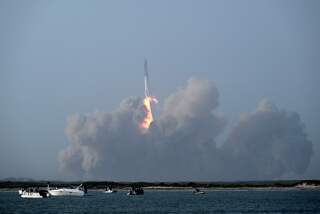Falcon hypersonic vehicle test flight fails
A test flight of an experimental aircraft traveling at 20 times the speed of sound ended prematurely Thursday morning when the arrowhead-shaped vehicle failed and stopped sending back real-time data to engineers and scientists who were monitoring the mission.
The unmanned aircraft, dubbed Falcon Hypersonic Technology Vehicle 2, was meant to test new technologies that could give the Pentagon the capability to deliver non-nuclear military strikes anywhere on the globe in less than an hour.
FOR THE RECORD:
Hypersonic aircraft: An article in the Aug. 12 Business section about the failure of a test of the Falcon Hypersonic Technology Vehicle 2 misidentified a former Air Force officer and expert in space security as Brian Weeded. His name is Brian Weeden. —
But the Falcon’s test flight ended prematurely and it plunged into the Pacific Ocean. It was the second and last scheduled flight for the Falcon program, which began in 2003 and cost taxpayers about $320 million. Both flights failed to go the distance.
The failure of the Falcon’s test flights doesn’t bode well for the Pentagon and the Obama administration, which were hoping to harness the hypersonic technology for use with 21st century ballistic missiles.
The plan is known as Prompt Global Strike, which the government hopes to field by 2015.
The administration requested $204.8 million for the effort in the upcoming budget year, and the Falcon is just one of an array of technologies in the works to accomplish the concept. But like the Falcon, none of the other projects has achieved much success.
In Thursday’s test, the Falcon was launched at 7:45 a.m. from Vandenberg Air Force Base northwest of Santa Barbara, into the upper reaches of the Earth’s atmosphere aboard an eight-story Minotaur IV rocket, made by Orbital Sciences Corp.
After reaching an undisclosed altitude, the aircraft jettisoned from its protective cover atop the rocket, then nose-dived back toward Earth, leveled out and glided above the Pacific at 20 times the speed of sound, or Mach 20. The plan was for the Falcon to speed westward for about 30 minutes before plunging into the ocean near Kwajalein Atoll, about 4,000 miles from Vandenberg.
But about 20 minutes into the mission, the Pentagon’s research arm, known as the Defense Advanced Research Projects Agency, or DARPA, announced on its Twitter account that: “Range assets have lost telemetry.” In other words, the military had lost touch with the aircraft.
The announcement sounded eerily similar to the problems that plagued the Falcon’s first flight, in April 2010. That test flight ended prematurely with engineers losing contact only nine minutes into the flight.
On Thursday, Air Force Maj. Chris Schulz, Falcon program manager, said in a statement, “Here’s what we know: We know how to boost the aircraft to near space. We know how to insert the aircraft into atmospheric hypersonic flight. We do not yet know how to achieve the desired control during the aerodynamic phase of flight. It’s vexing; I’m confident there is a solution. We have to find it.”
Sustaining hypersonic flight has been an extremely difficult task for aeronautical engineers over the years. While supersonic means that an object is traveling faster than the speed of sound, or Mach 1, “hypersonic” refers to an aircraft going five times that speed or more.
On both flights, the Falcon hit Mach 20. At that speed, an aircraft could zoom from Los Angeles to New York in less than 12 minutes — 22 times faster than a commercial airliner.
The Falcon, which is built by Lockheed Martin Corp., is made of durable carbon composite material, which was expected to keep the aircraft’s crucial internal electronics and avionics — only a few inches away from the surface — safe from the fiery hypersonic flight. Surface temperatures on the Falcon were expected to reach more than 3,500 degrees — hot enough to melt steel.
It is still too early to tell what precisely went wrong, but engineers will sift through the information gathered by more than 20 air, land, sea and space data collection systems, DARPA said.
This was the second failure of hypersonic technology this year. In June, the Air Force had to prematurely end a test flight of another experimental plane, the X-51 Wave Rider, when a lapse in airflow to the jet engine caused a shutdown.
Despite the failures, the Pentagon believes that hypersonic vehicles are the best hope for replacing nuclear-tipped intercontinental ballistic missiles as a way to hit a target in an hour or less — without launching World War III.
“The whole idea is that the military has time-sensitive information and needs to deliver a strike immediately,” said Brian Weeden, a former Air Force officer and expert in space security. “The only vehicle that the military currently has in its inventory with that kind of capability is” an intercontinental ballistic missile.
Other methods of hitting a distant target, cruise missiles and long-range bomber planes, take hours to reach their destination.
When pressed for an example, military officials point to an instance in 1998 when the U.S. military tried — and failed — to kill Osama bin Laden. Navy vessels in the Arabian Sea lobbed cruise missiles at training camps in Afghanistan, hitting their targets — 80 minutes later. By then, bin Laden was gone.
But now bin Laden is dead, which caused Weeden to question whether the funding would continue to flow for the technology amid the federal budget crisis.
“All of this money is being spent to kill someone very quickly,” he said. “All that seems to have come out of it is that the technology is costly and difficult to achieve.”
More to Read
Inside the business of entertainment
The Wide Shot brings you news, analysis and insights on everything from streaming wars to production — and what it all means for the future.
You may occasionally receive promotional content from the Los Angeles Times.











